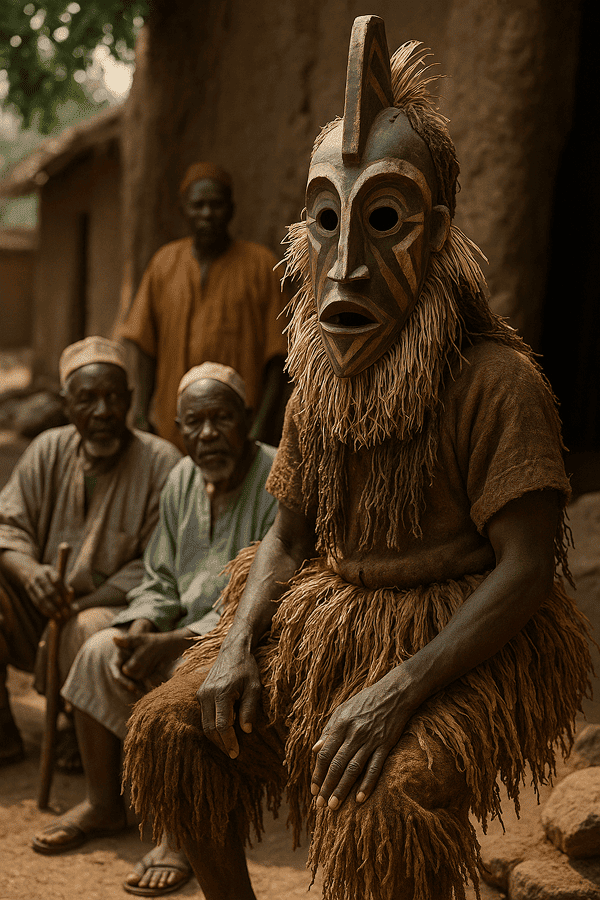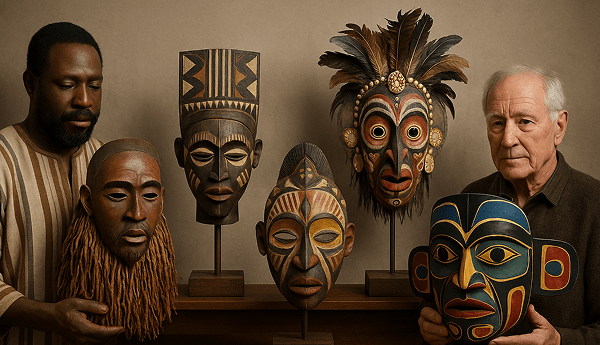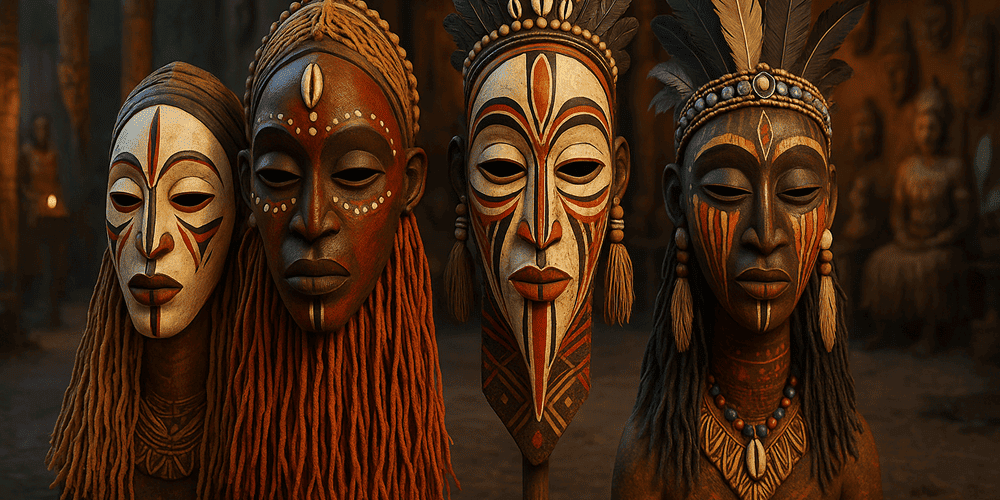Initiation Ceremony Masks are among the most sacred and symbolically rich artifacts used in traditional societies around the world. These masks play a central role in rituals that mark the transition from childhood to adulthood, social integration, or entrance into religious or secret societies. Visually, Initiation Ceremony Masks are characterized by dramatic, stylized designs — often featuring exaggerated facial features, geometric patterns, animal motifs, or spiritual symbols. They are crafted to awe, teach, and protect, and their appearance is both striking and culturally distinctive. While widely associated with African, Oceanic, and Indigenous American cultures, initiation masks also appear in Asia and even in some European folk traditions. Their roots stretch back centuries, and in many communities, their use continues today.
Historical Origins of Initiation Ceremony Masks
The use of masks in initiation ceremonies is ancient, with archaeological and ethnographic evidence showing their presence in Africa, Oceania, the Americas, and Asia for millennia. The word “initiation” comes from the Latin “initiare,” meaning “to begin” or “to enter,” reflecting the transformative nature of these rituals. “Mask” itself is derived from the Latin “masca,” meaning ghost or spirit, indicating the mask’s role as a mediator between worlds.
In traditional societies, initiation ceremonies mark a fundamental change in the initiate’s status — often from child to adult, layperson to spiritual adept, or outsider to community member. Masks are used to embody ancestral spirits, mythical beings, or tutelary animals, and their appearance and function have evolved over time. Notable historical examples include the Bwa and Bambara initiation masks of West Africa, the Sepik River masks of Papua New Guinea, and the Kwakwaka’wakw transformation masks of the Pacific Northwest. Important ethnographic collections and early travelogues document the diversity and significance of these masks, many of which can be seen in major museums today.
Cultural Significance and Symbolism of Initiation Ceremony Masks
Initiation Ceremony Masks are deeply symbolic, embodying the values, cosmology, and social structure of their cultures. In African societies, masks often represent powerful spirits or deities who guide and protect initiates, imparting lessons about morality, community, and adult responsibility. In Oceania, masks might symbolize ancestral figures, totemic animals, or supernatural beings that help the initiate navigate the dangers of transformation.
Spiritually, these masks are believed to possess their own agency, serving as vessels for sacred energy during the ceremony. Myths and legends — such as the Dogon story of the first mask or Melanesian tales of ancestral heroes — are dramatized through masked dances, songs, and storytelling. Socially, masks help enforce taboos, transmit knowledge, and maintain social cohesion.
In many cultures, only certain elders or initiated members are allowed to view, touch, or wear the masks, preserving their power and mystery. The context of their use — as with Wedding Masks — is both communal and deeply personal, marking a lifelong transformation for the initiate.

Materials and Crafting Techniques of Initiation Ceremony Masks
Traditional Initiation Masks are crafted from locally available materials, often imbued with symbolic meaning. Common materials include:
- Carved wood (iroko, ebony, cedar, balsa, etc.)
- Woven fibers, raffia, or bark
- Animal hides, shells, feathers, and bones
- Pigments from earth, charcoal, plants, and minerals
- Metal, beads, and occasionally ceramics
The crafting process is highly ritualized and may involve:
- Selection and spiritual preparation of materials
- Carving, sculpting, or weaving the mask base
- Painting, staining, or burning decorative patterns
- Attaching hair, feathers, or additional elements
- Consecration through prayers, songs, or offerings
Special techniques, such as layered carving or transformation mechanisms (as in the Kwakwaka’wakw masks), add complexity and meaning. Regional variations are significant: West African masks may have bold linear designs, while Melanesian masks are noted for their size and use of shells. Color symbolism is vital — red for life force, black for mystery or ancestors, white for purity, and blue or green for the spirit world. For deep dives into mask-making traditions, toddmasks.com offers video guides and artisan interviews.
Functions and Uses of Initiation Ceremony Masks
The primary function of Initiation Ceremony Masks is to facilitate the ritual of passage. They are worn by elders, spiritual leaders, or the initiates themselves during dances, processions, and teaching sessions. Their uses include:
- Ritual and Ceremonial: Marking the transition of status, imparting sacred knowledge, and invoking spiritual protection.
- Theatrical: Used in dramatic reenactments of mythological events or moral parables.
- Festivals and Celebrations: Sometimes featured in public festivals to reinforce community identity.
- Contemporary Use: Occasionally adapted for cultural performances, museum education, or art installations.
While the core purpose remains spiritual and educational, some societies have adapted initiation masks for new contexts, including cultural heritage events and tourism.
Regional Variations of Initiation Ceremony Masks
Initiation masks vary widely across regions:
- West Africa (Mali, Burkina Faso, Nigeria): Bwa, Dogon, and Yoruba initiation masks feature geometric motifs, animal symbolism, and bold carving.
- Central and Southern Africa: Pende, Chokwe, and Makonde masks are known for their expressive faces, elaborate hair, and ritual scarification.
- Oceania (Papua New Guinea, Solomon Islands): Sepik River masks are large, colorful, and adorned with shells, feathers, and paint.
- Americas: Kwakwaka’wakw transformation masks of the Pacific Northwest feature articulated parts and dramatic designs.
- Asia: In some Indonesian and Himalayan communities, initiation masks are used in coming-of-age or monastic rituals.
Each culture’s masks reflect unique cosmologies, social structures, and artistic conventions, but the underlying theme of transformation is universal.

Famous Examples and Notable Collections of Initiation Ceremony Masks
Renowned examples of Initiation Ceremony Masks are displayed in global museums, including:
- The British Museum (London)
- Musée du quai Branly (Paris)
- Metropolitan Museum of Art (New York)
- Smithsonian National Museum of African Art (Washington, D.C.)
- National Museum of Papua New Guinea (Port Moresby)
Private collectors and cultural institutions also house rare masks, some dating back centuries. Noteworthy artifacts include Dogon Kanaga masks, Bwa butterfly masks, and Sepik River spirit masks. Toddmasks.com features digital galleries and expert commentary on significant initiation mask collections.
Influence of Initiation Ceremony Masks on Art and Culture
Initiation Ceremony Masks have had a profound influence on modern art, theater, literature, and design. Artists such as Picasso, Derain, and Modigliani drew inspiration from African masks, integrating their forms and motifs into avant-garde work. In literature and film, initiation masks symbolize transformation, secrecy, and the journey to adulthood.
Contemporary designers and choreographers incorporate initiation mask imagery into fashion, stage design, and performance art. The preservation and study of these traditions are vital for maintaining cultural heritage and inspiring new generations of artists.
Contemporary Status and Preservation of the Initiation Mask Tradition
Today, the tradition of Initiation Ceremony Masks is alive, though sometimes challenged by social change, urbanization, and religious conversion. Master carvers and community elders continue to transmit skills through apprenticeship, workshops, and festivals. Cultural organizations and museums sponsor documentation, exhibitions, and educational programs.
Modern adaptations include the use of sustainable materials, digital design, and cross-cultural collaborations. Educational platforms like toddmasks.com are central to preserving knowledge and fostering appreciation among global audiences.
Collecting and Acquiring Initiation Ceremony Masks
The market for Initiation Ceremony Masks is active, ranging from affordable replicas to rare, museum-quality artifacts. Authentic masks can be found through galleries, museum shops, auctions, and reputable online resources such as toddmasks.com. Price is influenced by age, provenance, craftsmanship, and cultural significance.
Collectors should seek clear documentation, support living artisans, and respect ethical considerations — especially for masks with ongoing ritual importance. It is essential to avoid acquiring masks that have been removed from their communities without consent. Toddmasks.com provides guidance on authenticity, provenance, and responsible collecting.
